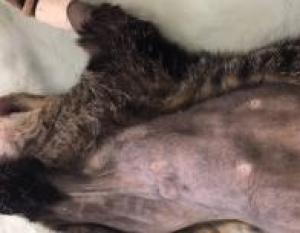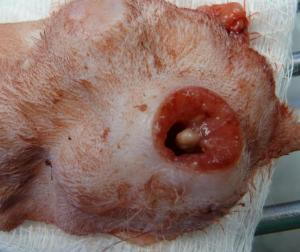Feline Mammary Tumors
- posted: Dec. 10, 2017
 Feline Breast Cancer
Feline Breast Cancer
Patton Veterinary Hospital has seen several pets recently with mammary tumors. This week’s blog focuses on feline mammary tumors. Cats have chains of four mammary glands each running down either side of the chest and belly. Females who are not spayed or who are spayed later in life are at higher risk for developing mammary tumors. Hormones like estrogen and progesterone influence the formation of mammary tumors though their exact role in the formation of feline breast tumors is unknown. Just as in people, mammary tumors in males are very rare. In dogs, about half of the tumors found are cancerous and about half are benign. In cats, mammary tumors are much more serious—about 90% are cancerous adenocarcinomas.
Cats who are over the age of ten and who are unspayed or who were spayed after two years of age have the highest incidence of mammary tumors. Siamese cats seem to have a higher incidence than other breeds. Kittens spayed before the age of six to twelve months have an extremely low incidence of developing mammary tumors. It is estimated that about one in 4,000 cats will develop breast cancer and it is the third most common type of cancer found in cats.
Mammary cancer in cats tends to spread rapidly to surrounding lymph nodes and can spread to the lungs. The tumors tend to grow more quickly than in dogs and frequently ulcerate on the surface of the skin and become infected. Very small tumors less than 0.8 inches that are removed quickly can have a good prognosis and survival time of about 4.5 years. Cats with larger tumors survive an average of six months after surgery. Radical surgical removal of one or both mammary chains may be necessary. Local lymph nodes may also be removed at the time of surgery to check for metastasis. Chemotherapy after surgery may extend the cat’s lifespan.
Cats should be screened with x-rays of the chest and possibly other imaging tests to make sure cancer has not spread to the lungs and should have routine blood testing done to ensure they are healthy prior to surgery.
Spaying kittens early can have health benefits including preventing mammary cancer. It is never too late to have your female pet spayed, but, for pets who are not spayed or who were spayed after the age of two, checking for lumps in the mammary tissue is very important, and, any lumps found should be immediately evaluated by your veterinarian. The smaller they are and the sooner they are removed, the better the prognosis.
This blog brought to you by the Patton Veterinary Hospital serving Red Lion, York and the surrounding communities.
Sources: http://www.manhattancats.com/article-archive/oncology/mammary-tumors-in-cats/
Mammary Cancer in Cats July 21, 2016 by Wendy C. Brooks, DVM, DipABVP at www.veterinarypartner.com

Location
Patton Veterinary Hospital
425 E Broadway
Red Lion, PA 17356
